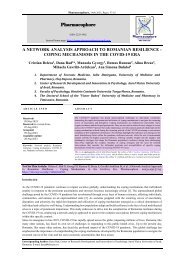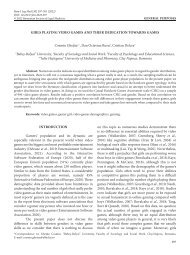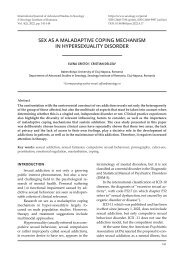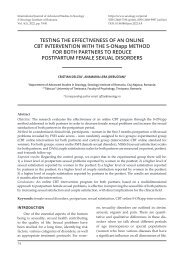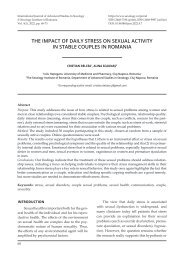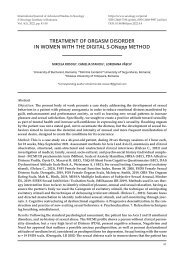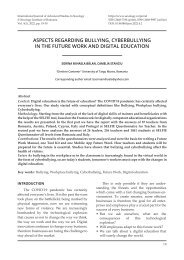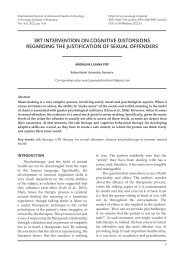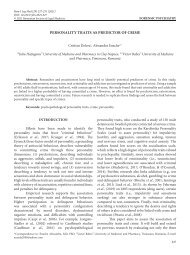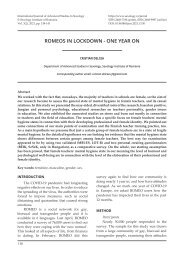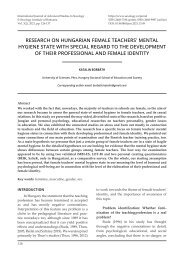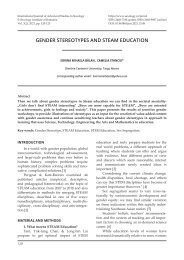DISORDER OF SEXUAL DESIRE OR AROUSAL IN WOMEN AND THE HISTORY OF SEXUAL ABUSE AS A PREDICTOR OF IT
The disorder of sexual desire or arousal is defined by the total or significant lack of sexual desire or arousal, and one of the associated factors or factos that are supporting this diagnosis is that of vulnerability of the individual, such as a history of sexual abuse. Numerous studies have shown that women who have a history of sexual abuse are more likely to develop sexual dysfunction.
The disorder of sexual desire or arousal is defined by the total or significant lack of sexual desire or arousal, and one of the associated factors or factos that are supporting this diagnosis is that of vulnerability of the individual, such as a history of sexual abuse. Numerous studies have shown that women who have a history of sexual abuse are more likely to develop sexual dysfunction.
You also want an ePaper? Increase the reach of your titles
YUMPU automatically turns print PDFs into web optimized ePapers that Google loves.
International Journal of Advanced Studies in Sexology<br />
© Sexology Institute of Romania<br />
Vol. 3(2), 2021, pp. 106-108<br />
https://www.sexology.ro/jurnal<br />
ISSN 2668-7194 (print), ISSN 2668-9987 (online)<br />
DOI: 10.46388/ijass.2021.13.44<br />
<strong>DIS<strong>OR</strong>DER</strong> <strong>OF</strong> <strong>SEXUAL</strong> <strong>DESIRE</strong> <strong>OR</strong> <strong>AROUSAL</strong> <strong>IN</strong> <strong>WOMEN</strong><br />
<strong>AND</strong> <strong>THE</strong> HIST<strong>OR</strong>Y <strong>OF</strong> <strong>SEXUAL</strong> <strong>ABUSE</strong> <strong>AS</strong> A PREDICT<strong>OR</strong> <strong>OF</strong> <strong>IT</strong><br />
ALEX<strong>AND</strong>RA TUD<strong>OR</strong><br />
The Sexology Institute of Romania, Cluj-Napoca, Romania<br />
Corresponding author email: office@sexology.ro<br />
Abstract<br />
The disorder of sexual desire or arousal is defined by the total or significant lack of sexual desire<br />
or arousal, and one of the associated factors or factos that are supporting this diagnosis is that of<br />
vulnerability of the individual, such as a history of sexual abuse. Numerous studies have shown that<br />
women who have a history of sexual abuse are more likely to develop sexual dysfunction.<br />
Key words: Disorder of desire or sexual arousal, DSM V, sexual abuse.<br />
<strong>IN</strong>TRODUCTION<br />
Disorder of desire or sexual arousal is the<br />
most common sexual disorder among women<br />
and leads to the greatest discomfort in a<br />
relationship.<br />
DEF<strong>IN</strong><strong>IT</strong>ION<br />
DSM 5 defines this disorder by the lack or<br />
significant reduction of sexual desire / arousal.<br />
It can be characterized by at least three of the<br />
following symptoms:<br />
• reduction or loss of interest in sexual<br />
activity;<br />
• absence or reduction of sexual thoughts /<br />
fantasies;<br />
• decreased or no initiation of sexual activity<br />
or response to the partner’s attempts to<br />
initiate sexual activity;<br />
• reduction or absence of sexual arousal or<br />
pleasure every time or almost every time;<br />
• reduction or absence of sexual interest or<br />
desire in the case of the majority of stimuli;<br />
• reduction or absence of sexual genital sensations<br />
or at the level of other erogenous zones<br />
during intercourse every time or almost<br />
every time (about 75-100%).<br />
Diagnostic elements<br />
A lower desire for sexual activity is not<br />
enough to diagnose the desire disorder or<br />
sexual arousal in women. They may have<br />
different symptoms and different ways of<br />
expressing sexual desire and arousal. When<br />
the symptoms present a persistent problem<br />
(minimum duration of about 6 months) the<br />
diagnosis of desire disorder or sexual arousal<br />
can be expressed. Also for the establishment<br />
of the diagnosis requires the presence of the<br />
symptoms mentioned above, accompanied by<br />
the presence of significant clinical discomfort.<br />
Associated elements that support the<br />
diagnosis<br />
In assessing and diagnosing disorder<br />
of desire or sexual arousal in women, the<br />
following five factors should be considered:<br />
partner-related factors (eg, partner’s health<br />
status), couple factors (eg, reduced communication),<br />
factors related to the vulnerability of the<br />
106
Disorder of sexual desire or arousal in women and the history of sexual abuse as a predictor of it<br />
individual (eg history of sexual abuse), cultural<br />
factors (eg various inhibitions) and medical<br />
factors relevant to the prognosis.<br />
Prevalence<br />
The global study on the attitudes and<br />
sexual behaviour has highlighted a prevalence<br />
of 26-43% for the lack sexual interest in the case<br />
of women aged 40-80 in 20 countries (Laumann<br />
et al., 2005 as cited in Delcea, 2011).<br />
Debut and evolution<br />
Although the definition of this disorder<br />
indicates that the lack of desire or sexual<br />
arousal is of lifelong existence, it can be classified<br />
into two types:<br />
Permanent - the absence of sexual desire or<br />
arousal from the first sexual experience;<br />
Acquired - difficulties related to sexual<br />
desire and arousal have appeared along the<br />
way, and can be consequences of some factors<br />
related to the partner, interpersonal or personal<br />
factors.<br />
Risk factors and prognosis<br />
Temperament factors - negative conceptions<br />
and attitudes towards sexuality and history of<br />
mental disorders;<br />
Environmental factors - problems in the<br />
couple’s relationship, stress factors during<br />
childhood, etc.<br />
Genetic and physiological factors - medical<br />
conditions<br />
In general, women acknowledge that an<br />
unhappy marriage, physical or emotional<br />
abuse, drug or alcohol addiction, and depression<br />
would influence sexual desire or arousal.<br />
However, when they examine their own relationship,<br />
they tend to justify the lack of sexual<br />
desire or arousal for a medical reason, never a<br />
psychological or interpersonal reason (Levine,<br />
Risen, & Althof, 2003).<br />
History of sexual abuse and sexual<br />
dysfunction in women<br />
There is considerable evidence that women<br />
with a history of sexual or physical abuse often<br />
develop various sexual dysfunctions (Fugl<br />
Meyer, 2006 as cited in Delcea, 2011). Previous<br />
traumas compromise the feeling of security,<br />
autonomy, mutual respect, feelings that are<br />
essential for the feeling of satisfaction and<br />
sexual pleasure (McCarthy & Breetz, 2010 as<br />
cited in Metz, Epstein & McCarthy, 2017).<br />
Motivated by fear of rejection or shame,<br />
sexually abused women often refuse to tell<br />
their partners about their abuse. This attracts<br />
feelings of insecurity about the relationship,<br />
the partner personally taking the woman’s<br />
negative attitudes and responses to sexual<br />
intercourse.<br />
Some partners who get to know about the<br />
abuse form negative expectations and wait for<br />
time to heal the trauma of the abuse, not being<br />
able to understand that the negative effects can<br />
persist and take the form of sexual dysfunctions<br />
(Metz, Epstein, & McCarthy, 2017).<br />
A study conducted in the US on the prevalence<br />
and predictors of sexual disorders found<br />
that victims of sexual abuse have a higher<br />
prevalence of sexual dysfunctions than people<br />
without a history of sexual abuse in childhood.<br />
The most common disorder among women is<br />
that of sexual arousal or desire, and among<br />
men erectile dysfunction and premature ejaculation.<br />
(Laumann, Piel & Rosen, 1999 as cited<br />
in Hall & Hall, 2011).<br />
Cognitive-behavioural approach in<br />
sexual dysfunctions<br />
This approach focuses primarily on<br />
same-sex or different-sex couples, but can be<br />
modified and adapted to individual therapy<br />
and involves the formation of skills that<br />
promote functioning and satisfaction in the<br />
couple’s relationship and sexual intercourse.<br />
This approach also has a psycho-educational<br />
component that is necessary for couples<br />
where partners may have a limited set of<br />
knowledge and feel embarrassed to talk about<br />
the physiology of the sexual organs or have<br />
poor psycho-sexual skills.<br />
This approach focuses on the intertwining<br />
of emotional responses, behavioural interactions,<br />
and thoughts that undermine sexual<br />
intercourse.<br />
107
ALEX<strong>AND</strong>RA TUD<strong>OR</strong><br />
In desire disorder / sexual arousal, the<br />
fundamentals of the approach cognitive-behavioural<br />
are the following:<br />
• Establishing emotional and sexual conditions<br />
for openness, receptivity and response.<br />
• Encouragement to create a sexual “voice”,<br />
taking responsibility for sexual desire and<br />
“building a bridge that leads to desire”<br />
(McCarthy & Wald, 2015 as cited in Metz,<br />
Epstein & McCarthy, 2017).<br />
• In the case of couples in which one of the<br />
partners has been sexually abused, clinicians<br />
ask a set of questions about the abuse as part<br />
of the sexual history. It helps the two partners<br />
talking to them about the long-term effects of<br />
an abuse and strategies to help the person in<br />
question heal (Metz, Epstein, & McCarthy,<br />
2017).<br />
CONCLUSION<br />
Desire disorder / sexual arousal is one of<br />
the most common sexual disorders among<br />
women.<br />
Women with a history of sexual abuse are<br />
more likely to develop a sexual dysfunction<br />
than women who have not experienced sexual<br />
trauma. For this reason, it is very important<br />
that each trauma is treated in time, because an<br />
untreated trauma will affect us at any time of<br />
life in different forms. According to the studies<br />
of Siserman C., Delcea C. , Vladi Matei H., Vică<br />
L. M. (2019) and Delcea C., Siserman C., (2020)<br />
we can argue that future research must bring<br />
new discoveries.<br />
BIBLIOGRAPHY<br />
1. American Psychiatric Association. (2016). DSM<br />
5 Manual de Diagnostic şi Clasificare Statistică a<br />
Tulburărilor Mintale. Bucureşti: Callisto.<br />
2. Delcea, C. (2011). Psihodiagnostic și evaluare clinică<br />
în tulburările sexuale. Cluj-Napoca.<br />
3. Hall, M., & Hall, J. (n.d.). The Long-Term Effects<br />
of Childhood Sexual Abuse: Counseling Implications<br />
.Retrieved from www.counseling.org: https://<br />
www.counseling.org/docs/disaster-and-trauma_<br />
sexual-abuse/long-term-effects-of-childhood-se<br />
xual-abuse.pdf?sfvrsn=2<br />
4. Levine, S., Risen, C., & Althof, S. (2003). Handbook<br />
of Clinical Sexuality for Mental Health Professionals.<br />
New York: Brunner Routledge.<br />
5. Metz, M., Epstein, N., & McCarthy, B. (2017).<br />
Cognitive-Behavioral Therapy for Sexual Dysfunction.<br />
Routledge.<br />
6. Siserman C., Giredea C., Delcea C., (2020). The<br />
Comorbidity of Paraphilic Disorders and Rape<br />
In Individuals Incarcerated For Sexual Offences.<br />
Rom J Leg Med [28] 278-282 [2020] DOI: 10.4323/<br />
rjlm.2020.278.<br />
7. Delcea C., Siserman C., 2020: Validation<br />
and Standardization of the Questionnaire<br />
for Evaluation of Paraphilic Disorders. Rom<br />
J Leg Med28(1)14-20(2020) DOI:10.4323/<br />
rjlm.2020.14Romanian Society of Legal Medicine.<br />
8. Siserman C., Delcea C. , Vladi Matei H., Vică L. M.<br />
(2019). Major Affective Distres in Testing Forensic<br />
Paternity. 2019. - Rom J Leg Med27(3)292-<br />
296(2019) DOI:10.4323/rjlm.2019.292 © Romanian<br />
Society of Legal Medicine<br />
108




